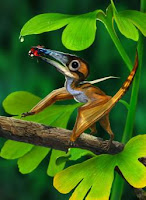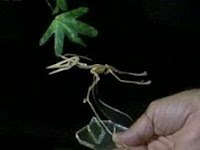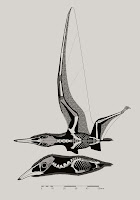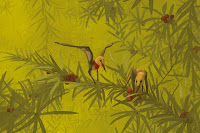As a longtime dinosaur fan and paleontology enthusiast, I've come to expect certain things in my life. One, I will always get dinosaur-related gunk for my birthday and Christmas (and generally get rid of it at
SVP's annual auction, unless it's actually something cool). Two, people will always send me links to paleontology news items.
Sometimes the item will genuinely be news to me. Often, though, (especially with dinosaur news) it's just the popular dissemination of something I already knew about. By the time something actually gets published (and reported), it's likely to have spread through the paleo grapevine already—personal communication, online forums, blogs, presentations at meetings (and the associated abstract volumes), etc.
Sometimes this can be mildly annoying for the paleo-aficionado. Right now I am sitting on some pretty cool stuff that I can't discuss with just anybody. But proper research takes time and proper publication takes time.
The former is a necessary evil, but the latter really isn't. Currently the publication process goes something like this:
- A writer (or a group of writers) submits a paper to a journal.
- One of the editors gets around to reading it. If they don't think it's appropriate, it's back to step 1 with a different journal.
- If they do think it's appropriate, they contact one or more potential anonymous reviewers.
- Assuming the people contacted agree to review the paper, and then actually do review the paper, the editor looks over the reviews and adds his/her own opinion. If the consensus is negative, we're back to step 1 (possibly preceded by a rewrite).
- If the consensus is positive, then the writer (or head writer) is alerted. At this point the writer(s) may respond to the reviews and make any necessary changes to the paper. A final draft is submitted.
- The final draft gets typeset and sent to the writer(s) for approval. Any final errors are (hopefully) smoothed out and sent to the printer.
- At some point, the paper is finally published.
As can be imagined, this process often takes a very long time. In my own limited experience, it took nearly two years from my first submitted manuscript (which was rightfully rejected) to the actual printing of my final paper (which was rightfully accepted!). Now, over a year of that was taken up with rewrites, but that still leaves about half a year spent just on the process of publication. And, from what I've heard, that's relatively short. (Lucky me!)
Internet publishing could drastically change that. On the Internet, you can almost instantly publish content globally (without killing any trees, either). Already there are some primarily online journals, like
Palaeontologia Electronica, and
Nature has an online outlet for non-peer-reviewed research at
Nature Precedings. Going forward, we are probably going to see a lot of publication migrate from paper to the Internet. (I myself already read far more papers as PDFs than in print.)
This might have positive repercussions beyond that of simply getting scientific information out there faster. Let's take a look at a current event in the paleontologist world:
Last year, Darren Naish wrote a
blog post noting that two separate papers had given a new genus to a species of aetosaur* (or, as Naish calls them, "armadillodiles"),
"Desmatosuchus" chamaensis. First there was
Rioarribasuchus Lucas, Hunt, and Spielmann 2006 (December), and then
Heliocanthus Parker 2007 (January). For a full timeline of these events and related events, see
this page on Mike Taylor's website.
How did this redundancy happen? Investigation is still pending, but it is notable that William Parker's (28-page) paper was accepted in December of 2005 and that Spencer Lucas was aware that the paper was in press. Lucas et al.'s (2-page) paper was published in the
New Mexico Museum of Natural History and Science Bulletin, a bulletin which Lucas (among others) edits. As editor of a museum's bulletin, it's possible to get things published much faster than the 13 months it took for Parker's paper to go from acceptance to publication. It looks an awful lot like a "claim jump", which is in violation of ICZN ethics (although that would not invalidate the name
Rioarribasuchus—Christopher Taylor wrote a post with more details on what the ICZN says
here.) But there hasn't been a proper investigation yet, and Lucas hasn't made a public response to the claims of wrongdoing.
I won't speculate on whether or not Lucas et al. are guilty of a breach of ethics, but I will speculate on what would have happened if scientific publications were just published online instead of in print. I think Parker's paper would have gone online in December of 2005 and his
Heliocanthus would not be a junior objective synonym. In fact, since
Heliocanthus was actually first named in Parker's 2003 thesis, he might have gotten it published even sooner than 2005. (The ICZN does not consider names published in theses to be valid. [
Correction.—the ICZN does not consider names in unpublished theses to be valid, and Parker's thesis was not published. Thanks to David Marjanovic for that correction.]) None of this would have even been an issue.
Online publishing won't solve every problem, but I think it will make this sort of taxonomic shenanigan much less common. Of course that's no comfort to anyone involved in this situation (dubbed "Aetogate"), and scientists should be held to proper ethical conduct, anyway. Still, though, the faster scientific publication moves online, the better, in my opinion.
* pronounced more or less like "I eat a sore"




